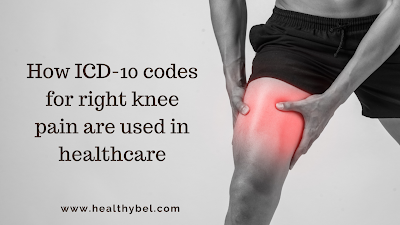If you've ever experienced knee pain, you know how discomforting it can be. Not only does it limit your mobility, but it can also affect your quality of life. However, finding the right diagnosis and treatment for your knee pain can be a daunting task, especially when medical professionals use a complex system of codes to classify and bill for services. That's why it's essential to understand ICD-10 codes, specifically for right knee pain. These codes are used by healthcare providers to describe and document medical conditions accurately. In this article, we'll dive into what ICD-10 codes are, how they work, and most importantly, what you need to know about them when dealing with right knee pain. Whether you're a patient, healthcare provider, or simply curious about the medical coding system, this article will provide you with the necessary information to navigate ICD-10 codes for right knee pain successfully.
What are ICD-10 codes for right knee pain?
ICD-10 codes are a system of alphanumeric codes used by healthcare providers to classify and document medical diagnoses and procedures. The International Classification of Diseases, Tenth Revision (ICD-10), is the latest version of this system and is used worldwide. The codes are used to describe a patient's medical condition or injury and are used for billing purposes, research, and statistical analysis.
When it comes to right knee pain, there are specific ICD-10 codes used to describe the condition. These codes are used to document the cause of the pain, the location of the pain, and the severity of the pain. The codes used for right knee pain fall under the category of "disorders of the musculoskeletal system and connective tissue."
How ICD-10 codes for right knee pain are used in healthcare
ICD-10 codes for right knee pain are used in healthcare primarily for billing purposes. When a patient visits a healthcare provider for right knee pain, the provider will document the medical condition using the appropriate ICD-10 code. This code will be used to bill the patient's insurance company for the services provided.
ICD-10 codes are also used for research and statistical analysis. By using these codes, healthcare providers can track the prevalence and incidence of specific medical conditions, including right knee pain. This data can be used to improve healthcare outcomes and develop new treatments for conditions such as right knee pain.
Key benefits of using ICD-10 codes for right knee pain
Using ICD-10 codes for right knee pain has several key benefits. For healthcare providers, these codes help ensure accurate documentation of medical conditions, which is critical for billing and reimbursement. Additionally, the use of ICD-10 codes for right knee pain can help providers track the prevalence and incidence of the condition and improve healthcare outcomes.
For patients, the use of ICD-10 codes for right knee pain can help ensure accurate billing and reimbursement from insurance companies. It can also help patients better understand their medical condition and the treatment options available to them.
Common ICD-10 codes for right knee pain
There are several common ICD-10 codes used to describe right knee pain. The specific code used will depend on the cause and location of the pain. Here are a few examples:
- M25.561 - Pain in the right knee
- M17.11 - Unilateral primary osteoarthritis, right knee
- M23.81 - Other internal derangement of right knee
- M76.81 - Patellar tendinitis, right knee
- S83.211A - Sprain of medial collateral ligament of right knee, initial encounter
It's important to note that these codes are just a few examples of the many codes used to describe right knee pain. Healthcare providers will use the appropriate code based on the patient's specific medical condition.
How to properly code for right knee pain
Properly coding for right knee pain requires a thorough understanding of the ICD-10 coding system. Healthcare providers must document the patient's medical condition accurately and use the appropriate code to describe the condition. Failure to do so can result in inaccurate billing and reimbursement.
When coding for right knee pain, healthcare providers must consider the cause and location of the pain. They must also document the severity of the pain and any other relevant medical conditions that may be contributing to the pain.
Challenges in coding for right knee pain
Coding for right knee pain can be challenging for healthcare providers. There are many different codes to choose from, and selecting the appropriate code requires a thorough understanding of the patient's medical condition. Additionally, the ICD-10 coding system is complex, and healthcare providers must stay up-to-date with changes to the system.
Another challenge in coding for right knee pain is ensuring that the code accurately reflects the severity of the pain. This is important for accurate billing and reimbursement and for tracking the prevalence and incidence of the condition.
Tools and resources for ICD-10 coding for right knee pain
There are several tools and resources available to healthcare providers to help with ICD-10 coding for right knee pain. These include coding manuals, online resources, and training programs. Healthcare providers can also consult with colleagues and industry experts for guidance on proper coding procedures.
Patients can also benefit from resources such as online forums and patient advocacy groups, which can provide information and support related to right knee pain and the ICD-10 coding system.
Best practices for using ICD-10 codes for right knee pain
To ensure accurate coding for right knee pain, healthcare providers should follow these best practices:
- Document the patient's medical condition accurately and thoroughly
- Use the appropriate ICD-10 code to describe the condition
- Ensure the code accurately reflects the severity of the pain
- Stay up-to-date with changes to the ICD-10 coding system
- Consult with colleagues and industry experts when necessary.
Patients can also follow these best practices by staying informed about their medical condition and communicating with their healthcare provider to ensure accurate documentation and coding.
Conclusion and final thoughts
Understanding ICD-10 codes for right knee pain is essential for both healthcare providers and patients. These codes are critical for accurate billing and reimbursement, tracking the prevalence and incidence of the condition, and improving healthcare outcomes. By following best practices and using the appropriate codes, healthcare providers can ensure accurate documentation of right knee pain, leading to better patient outcomes and improved healthcare overall. Patients can also benefit from understanding the ICD-10 coding system and advocating for accurate documentation and coding of their medical condition.





Comments
Post a Comment